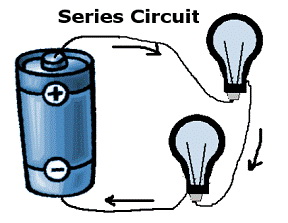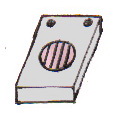Introduction to Electric circuit
An electrical circuit is a closed loop formed by a power source, wires, a fuse, a load, and a switch. When the switch is turned on, the electrical circuit is complete and current flows from the negative terminal of the power source, through the wire to the load, to the positive terminal. Any device that consumes the energy flowing through a circuit and converts that energy into work is called a load. A light bulb is one example of a load; it consumes the electricity from a circuit and converts it into work — heat and light.
A very simple circuit, for example, might consist of a battery, some wire, a switch, and an incandescent light bulb. The battery supplies the energy required to force electrons around the loop, heating the filament of the bulb and causing the bulb to radiate a lot of heat and some light. Energy is transferred from a source, the battery, to a load, the bulb.
What is a Simple Circuit?
A simple circuit consists of three minimum elements that are required to complete a functioning electric circuit: a source of electricity (battery), a path or conductor on which electricity flows (wire) and an electrical resistor (lamp) which is any device that requires electricity to operate. The illustration below shows a simple circuit containing, one battery, two wires, and a bulb. The flow of electricity is from the high potential (+) terminal of the battery through the bulb (lighting it up), and back to the negative (-) terminal, in a continual flow.
Schematic Diagram of a Simple Circuit
Simple Circuit
The following is a schematic diagram of the simple circuit showing the electronic symbols for the battery, switch, and bulb
Appliances may be placed into an electric circuit in one of two ways. In a series circuit, current flows through the appliances one after the other.
In a parallel circuit, an incoming current is divided up and sent through each separate circuit independently.
An important adva ntage of parallel circuits is their resistance to damage.
ntage of parallel circuits is their resistance to damage.
Suppose that any one of the appliances in a series circuit is damaged so that current cannot flow through it. This breakdown prevents current from flowing in any of the appliances.
Such a problem does not arise with a parallel circuit. If any one of the appliances in a parallel circuit fails, current still continues to flow through the other appliances in the circuit.
Some Electrical Symbols
Description | Picture | Symbol |
a connecting wire |  | |
a bulb |  | |
a switch |  | |
a battery |  | |
a motor |  | |
a buzzer |  |
Want to know more about Electric circuit? Click here to schedule live help with an etutor!
About eAge Tutoring
eAgeTutor.com is the premium online tutoring provider. Using materials developed by highly qualified educators and leading content developers, a team of top-notch software experts, and a group of passionate educators, eAgeTutor works to ensure the success and satisfaction of all of its students.
Contact us today to learn more about our guaranteed results and discuss how we can help make the dreams of the student in your life come true!